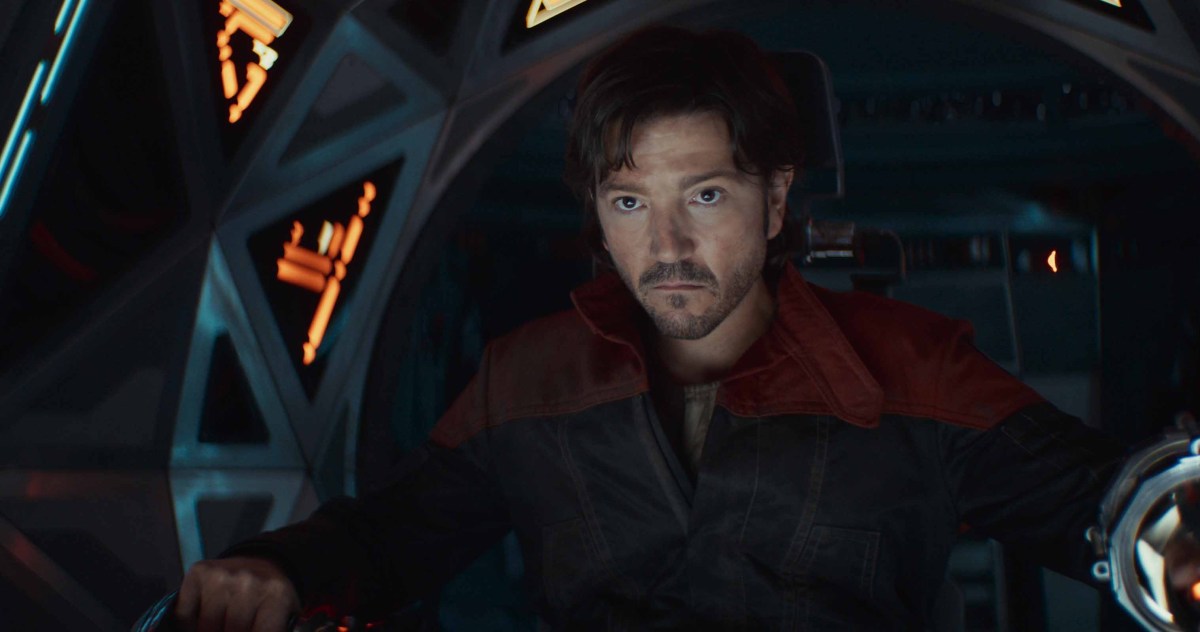
By halfway through the first episode of Andor’s second season, fledgling rebel Cassian Andor (Diego Luna) has run across a complication on his latest mission: a band of rebel soldiers who see him as a threat rather than an ally. In fact, they seem to see just about everything as a threat: the critters in the extensive jungle around them, any outsiders they run across, even the other members of their own group. From the first moment Cassian meets them — at gunpoint, in a mass confrontation — they’re already loudly arguing with each other about the right way to capture him.
We’ve never seen this fractious, incompetent group before — but thanks to a few small references in Andor season 1, we know a few things about who they are, and possibly how they wound up stranded at Cassian’s drop point. Here’s how these loud, flailing goobers fit into Andor’s continuity — and how they fit into what seems to be this season’s overarching theme.
[Ed. note: Minor spoilers ahead for episodes 1 and 2 of Andor season 2, and for a small subplot in season 1.]
After capturing Cassian, the rebel group argue among themselves about where they could possibly go next, assuming they can either learn to use Cassian’s stolen experimental TIE Avenger or talk him into transporting them. It’s clear that in addition to not having any agreed-upon leader in the group, they don’t have any sort of headquarters or clear goal. From the arguments, we also know they’ve been stuck on the planet for two days, with minimal food and supplies. From one member, Cassian learns they’re members of the Maya Pei Brigade, one of the rebel groups his sponsor/handler Luthen Rael (Stellan Skarsgård) has been backing.
Who is Maya Pei, the rebel leader?
We’ve also never seen Maya Pei in Andor, but she’s been mentioned a few times by Saw Gerrera (Forest Whitaker), who brings her up in a rant about various anti-Empire rebel factions he disdains as “lost” because they lack his “clarity of purpose.” In a scene in season 1’s “Narkina 5,” he sneers at Luthen that he wouldn’t work with Maya Pei because she’s a “neo-Republican.” (Luthen for his part describes Saw as an anarchist, though seemingly one he’s still willing to work with.)
She gets another quick mention from Dedra Meero (Denise Gough) in an ISB meeting in season 1 — Luthen’s attempt to buy an Imperial Starpath Unit from Cassian in season 1 apparently happened “in a safehouse run by a rebel cell associated with Maya Pei.” While the ISB is aware of her existence, though, she never becomes a significant part of Andor’s story; she’s just a background detail, the head of one of many independently operating rebel groups Luthen is helping supply and sometimes coordinate.

Curiously enough, the collapse of the Maya Pei Brigade seems to mirror what happens to another of Luthen’s splinter rebellion projects in season 1: the one run by Anto Kreegyr, who Luthen cold-bloodedly sells out in season 1 in order to keep one of his Empire informants protected. A particularly complicated bit of spycraft-versus-spycraft feinting and counterfeiting leads Luthen to sacrifice Kreegyr and his group, allowing them to carry out a guerilla attack on an Imperial power station without warning them that one of their pilots has been caught and interrogated, and the Empire has laid a trap for them.
Maya Pei’s group says something similar happened to them — “We got ambushed! We lost six ships, 40 fighters!” one of them tells Cassian. Maya herself was apparently caught in the crossfire, though the group is divided on whether she’s dead, and on what exactly happened in the thick of battle.
How does the Maya Pei Brigade fit into Andor’s story?
What’s more significant about the disintegrating remnants of the Maya Pei Brigade is how this squabbling group of survivors helps carry forward some of the biggest ideas at play throughout the show — the many, many fracture points in a factionalized rebellion, and how difficult it is to bring one to bear against unified totalitarian rule. That theme plays out in a wide variety of ways across Andor’s two seasons, from Mon Mothma’s genteel political rebellion in the Senate and secretive funding efforts outside of it to Luthen’s schemes, Cassian’s adventures, and the major ISB project in season 2.
Here, though, the theme operates on a particularly small scale, and a particularly impassioned one. Maya’s surviving forces don’t agree about their goals or how to pursue them, about who should lead the group or what their organizer would have wanted. They don’t even agree about what just happened to them, or their leader. Their suspicions against each other and against everyone else make them a danger to themselves and to any other part of the rebellion that touches them. And as long as they maintain that suspicious, chaotic response to the collapse of their own faction, they’re incapable of seeing an ally when he appears. (It doesn’t help that Cassian is trying to maintain basic operational security by not explaining his mission to them, or admitting who he reports to.)

Their internal group squabbling mirrors the larger conflict we saw in season 1, as represented by Saw Gerrera’s contemptuous take on other rebel groups: In theory, all the organizations he mentions in his rant are on the same side, along with Luthen. They all want an end to the Empire, with its oppression and overreach. But they don’t agree philosophically about how to pursue their goals, or what might replace the Empire in their ideal galaxy. Saw dismisses them all as “separatists,” not acknowledging that he, too, is part of the problem — judging other factions of rebels as unworthy, and refusing to cooperate with them.
All of this points to a tension between different crucial aspects of the rebellion. It’s necessary for all these little splinter groups to operate independently of each other as much as possible, for information segregation and deniability. But there’s a limit to how much any of them can accomplish with a small band of people dedicated more to a specific leader and a narrow philosophy than to the cause that unites them.
And all of this is building up to the rest of the action in season 2, as the scattered, splintered rebellion seen in patchy glimpses throughout season 1 becomes the more functional, dedicated organization seen in Rogue One and the original George Lucas Star Wars trilogy. Where the biggest-picture story in Andor season 1 was about Cassian’s transformation from head-in-the-sand cynic to dedicated freedom fighter, season 2 takes on some bigger ideas about how individual members of an insurrection having clarity of purpose isn’t enough to make a rebellion successful — not when it’s divided up among factions who have different clarities of purpose, like Saw, or no clarity at all.
From Polygon via this RSS feed


